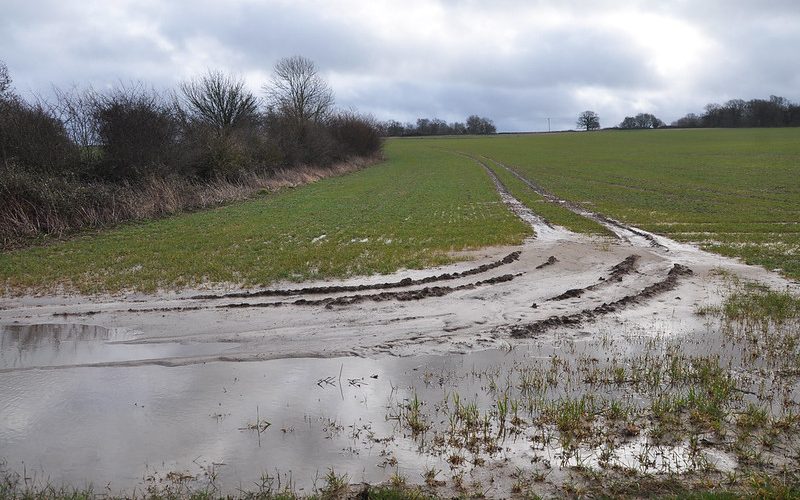Scrap the pumps- bring in the worms!
It is becoming increasingly apparent that our approach to flood management needs a re-think. Expensive structures and barriers, pumps and sluices might look impressive but if all they do is push the water into someone else’s kitchen further down-stream then it’s a rather hollow victory. Likewise, dredging tonnes of lost topsoil from the river beds so the water can “get-away” more quickly does not address the question of how and why the soil got there in the first place.
So what can we do? Well firstly a few centimetres of water across the top of a large catchment is much easier to manage than a fast-moving raging torrent concentrated into a narrow river valley further down. I have reached the conclusion that the solution lies in an integrated approach where a series of step-wise measures are employed, starting on the ground at the top of the catchment and employed systematically downwards through the system. The Allerton Project, based on an 800 acre mixed farm in Leicestershire, began to look at this idea 15 years ago.
In our catchment I observed farmers placing straw bales at the bottom of fields affected by soil erosion to keep the soil in the field – a sort of low tech flood barrier. The technique is about as effective as some of our more expensive defences! Yet if we were to make the soil more absorbent then we can reduce the volume of surface flow by enabling higher levels of infiltration so the water doesn’t run across the surface and down the slope. For instance, our research has shown that moving away from ploughing to lighter surface cultivations prevents the so-called plough pan forming- a layer of compaction just below where the plough furrow passes through the soil- which increases infiltration. This then increases earthworm numbers. Earthworms create a myriad of tunnels in the soil which allow water to infiltrate more rapidly and in greater volume.
Without the plough the crop residues remain on the surface because they are not buried, protecting the soil from erosion, and because we disturb the soil less, we need lower horse-power, lighter weight tractors which in-turn cause less compaction. We can also fit our tractors and other machines with low ground-pressure tyres which reduces compaction further- less compaction, better infiltration.
We can grow cover crops on land which is not destined to be sown with a commercial crop until spring time, thereby protecting the soil. This adds organic matter, which in turn improves water holding capacity; tap rooted plants create deep channels that water can flow into; plants such as fodder radish push the soil open with their strong “tap” roots allowing water to infiltrate; we can manipulate our rotations and add organic matter by including grass leys and spreading in livestock manures and composts, which help the soil absorb water. All these measures are the first line of defence- to keep the water as close to where it lands when it first falls from the clouds.
Then comes the second line of defence; placing vegetative buffer strips in the field margins to slow the lateral movement of soil and water or grassing down shallow depressions in fields where water gathers, washing soil away. Beetle banks can be placed stragically across slopes- soil erosion is caused by the VOLUME of water and the VELOCITY it travels at- the beetle bank provides a barrier and puts the brakes on the flow. Retention ponds can be dug; Allerton’s Head of Research Prof. Chris Stoate came up with the clever idea of damming field ditches on sloping land and feeding the water into settlement ponds dug in the field corners, an area of low agricultural productivity. These ponds are great for wildlife in summer, but they also allow sediment to settle out and hold water up higher in the catchment reducing the peak flow and consequently flooding downstream.
The third line of defence is to sacrifice areas, such as grassy fields in flood-plane where water can accumulate, or the creation of riparian strips with marshy absorbent ground and ponds and water retention channels. Only when we have done all this should we move to the fourth line of defence where the barriers and pumps can be brought in.
All well and good I hear you say- but who is going to pay for all this?
Actually that’s not the problem it might appear. Many farmers have switched away from ploughing because the alternative is less costly; field margin strips and beetle banks are paid for options in Environmental Stewardship Schemes or can be counted as part of a farmer’s mandatory Ecological Focus Area requirements; field corner ponds are a new Stewardship option and if you look after your earthworms, well they come for free, indeed at a fraction of the cost of an expensive pump and immune to failure in a power cut!
This is why agroecology is increasingly being seen as a way forward. Agroecology takes a holistic approach and seeks to work more closely with nature so that we can continue to keep our farms in business producing quality home-grown food, whilst enhancing our wildlife, our pollinators and protecting our soil, which belongs in our fields not on our river-beds or in other peoples’ houses.
Editor’s comments
You can find lots of useful resources in line with Alastair’s suggestions on Agricology. Here are some to get you started:
- ADAS’ ‘Field Drainage Guide’ contains useful guidance on assessing your fields and soil, ways of reducing soil damage when using machinery, installing drainage systems, and other land management options Alastair mentions, including creating wet grassland and buffer strips.
- If you want help with choosing plants with strong tap roots, the Cotswold Seeds / Garden Organic publication ‘Sort out your soil’ is a good place to start; it contains detailed species profiles and guidance to help you select the most appropriate cover crops according to your soil type or farming system.
- The IBERS factsheet ‘ Grass-clover leys in organic rotations’ provides useful information on incorporating grass leys into rotations, as does ‘Rotations for Organic Horticultural Field Crops’ by the Soil Association, which includes recommendations to help you plan and manage crop rotations and incorporate grass leys.
- The SRUC briefing ‘Riparian buffer strips’, while focussed on attracting insect pollinators, provides some important management tips that will also help prevent poaching and flooding.
- ‘Beetles you can bank on’ gives tips on creating beetle banks based on first-hand experience, and describes additional benefits you can get from incorporating them into your farming / growing system.
- The AHDB manual ‘Improving Soils for Better Returns’ contains information to help you improve drainage in your soil but also graphically illustrates the impact of poor drainage and waterlogged fields on your livestock. It gives management advice to help rectify compaction and poaching.
And finally…
- The FiBL publication ‘Earthworms – Architects of fertile soils’ will help you “look after your earthworms” as Alastair suggests. It includes insights into the capacity of earthworms to improve water infiltration and reduce surface run-off and the impacts of different tillage systems on their abundance and function.


